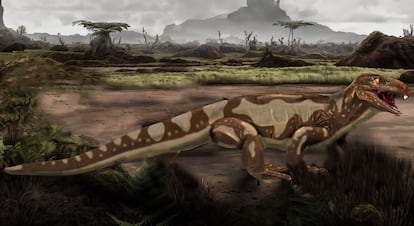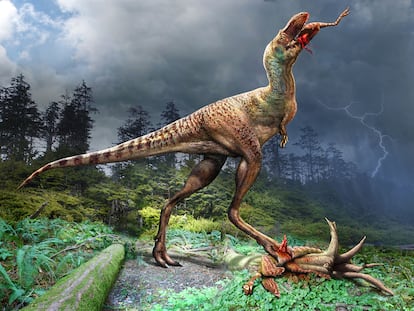Fossilized reptilian skin sheds light on how animals conquered the Earth
The discovery was made in Oklahoma and shows how one of the first land animals, who lived 290 million years ago, had scales like lizards

In the Carboniferous, a geological period from 359 to 298 million years ago, four-limbed tetrapods began to come out of the water. Researchers have now discovered 289-million-year-old skin that once belonged to an amniote, a fully terrestrial animal. This tissue still preserves several of its layers, and based on its patterns, with scales and protuberances, everything indicates that these creatures had an epidermis similar to that of lizards. This innovation was key for amniotes, the ancestors of reptiles, birds and mammals, to conquer a whole new territory, the continents.
Skin, like the rest of the tissues and organs, deteriorates over time. Internal bacteria, external microorganisms, the action of oxygen and the chemical reactions triggered by contact with minerals all work together to strip vertebrates down to the bones. It is teeth and bones that are best preserved, such as that of a whale from 40 million years ago, which is considered the heaviest animal that ever inhabited the Earth.
But, sometimes, the soft parts fossilize as they mineralize, leaving them as a relief on a stone. Even rarer is the discovery of skin that preserves its three-dimensional structure, like what Canadian paleontologists have just discovered. And this case is even more exceptional because the epidermis in question is from one of the Earth’s first land animals.

The skin, found at the site of Richards Spur, Oklahoma, is fragmented and all the pieces together are no larger than a fingernail, but its study under a microscope revealed epidermal tissues, a hallmark of amniote skin. As the researchers explained in the scientific journal Current Biology, the skin preserves “tuberculate scales with a pebbled texture” similar to crocodile skin, while the outermost part is made up of scales ending in horn-like tissue formed by hardened keratin.
“Fully terrestrial”
For the paleontologist Robert Reisz from the University of Toronto (Canada), corresponding author of this research work, “the presence of this type of skin indicates that we are dealing with a fully terrestrial animal.” It is believed that in the long transition to the new way of life, there must have existed groups of animals that, like amphibians, had semiaquatic characteristics. “Geological and paleoclimatological work indicates that this animal lived in a tropical environment, with a monsoon-type climate,” adds Reisz.
An epidermis like the one described could not be an amphibian. The skin of these animals has glands that keep it moist, something that was not required in a dry environment. In addition, their bare skin helps them breathe oxygen, which they could not do with keratinized scales. “The first terrestrial vertebrates also included amphibians, but here we are talking about amniotes. This means that the first amniotes, the common ancestor of living reptiles, birds, mammals and their extinct relatives, had this type of skin,” concludes Reisz.
Amniotes are four-legged vertebrate animals. One of the greatest innovations that allowed life on the terrestrial portion of the planet was the development of up to four layers that protect the embryo, housing food and moisture. With this, oviparous reproduction in a dry environment became possible. But these newcomers also brought along other innovations, such as exclusive lung breathing and dry skin. Thanks to the accumulation of keratin in the epidermis, the scales formed a barrier that, while preventing dehydration, protected them from external aggressions such as rain or sunlight.
Along with this skin, traces of fossilized epidermis were also found attached to the vertebrae of a small animal, the Captorhinus aguti, an amniote barely 30 centimeters long. This has led Ethan Mooney, lead study author and also from the University of Toronto, to suggest that the skin they have discovered is from this same animal: “It is reasonable to assume that these isolated skin fragments are actually from a C. agouti because they have horn-like components and we also see horn-like structures arranged in bands on the skeleton of one of these animals.”
Hundreds of thousands of bones have been found at the same site and the majority are of this species. “This animal was the most abundant at this site and is also one of the first reptiles, so we feel there is evidence that it has at least similar skin structures. So it’s likely that they belong to him, but we can’t say for sure,” said Mooney.
Sign up for our weekly newsletter to get more English-language news coverage from EL PAÍS USA Edition
Tu suscripción se está usando en otro dispositivo
¿Quieres añadir otro usuario a tu suscripción?
Si continúas leyendo en este dispositivo, no se podrá leer en el otro.
FlechaTu suscripción se está usando en otro dispositivo y solo puedes acceder a EL PAÍS desde un dispositivo a la vez.
Si quieres compartir tu cuenta, cambia tu suscripción a la modalidad Premium, así podrás añadir otro usuario. Cada uno accederá con su propia cuenta de email, lo que os permitirá personalizar vuestra experiencia en EL PAÍS.
¿Tienes una suscripción de empresa? Accede aquí para contratar más cuentas.
En el caso de no saber quién está usando tu cuenta, te recomendamos cambiar tu contraseña aquí.
Si decides continuar compartiendo tu cuenta, este mensaje se mostrará en tu dispositivo y en el de la otra persona que está usando tu cuenta de forma indefinida, afectando a tu experiencia de lectura. Puedes consultar aquí los términos y condiciones de la suscripción digital.
More information
Archived In
Últimas noticias
More than 40 Democratic lawmakers urge Trump in a letter to stop his ‘attempts to undermine democracy in Brazil’
The journal ‘Science’ criticizes Trump’s anti-renewable energy policy: ‘The US is failing to benefit from its own innovations’
Cubans hope for a miracle as dengue and chikungunya spread
The long shadow of the father figure in the films of Rob Reiner
Most viewed
- Christian Louboutin: ‘Young people don’t want to be like their parents. And if their parents wear sneakers, they’re going to look for something else’
- Cartels in Mexico take a leap forward with narco-drones: ‘It is criminal groups that are leading the innovation race’
- ‘El Limones’ and the growing union disguise of Mexican organized crime
- Liset Menéndez de la Prida, neuroscientist: ‘It’s not normal to constantly seek pleasure; it’s important to be bored, to be calm’
- The low-cost creative revolution: How technology is making art accessible to everyone










































